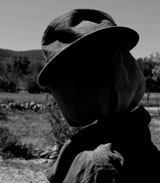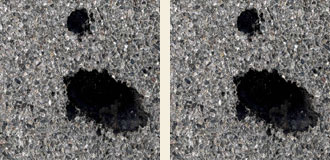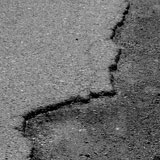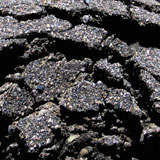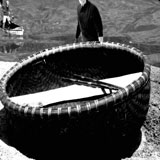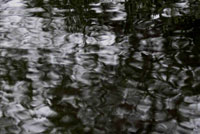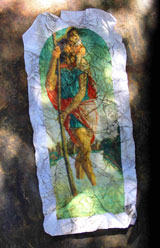
| CHO Current Issue | Contents Page - This Issue | Articles | Archives |
June 2006, vol 2 no 2
|
Dru Philippou road to Macadam 14th March, 2006. One early morning during a full moon lunar eclipse, unable to sleep, I get in my car and drive south. In the rearview mirror, Colorado's snow-capped Mount Blanca diminishes with distance, to the right a bald turkey buzzard tears at a carcass, to the left last summer's scarecrow listens to the seeds germinating beneath the earth, each pulling the other to the coming of life.
Continuing south, I pass a traveller carrying a heavy backpack. Jack Kerouac's words come to mind:
The road provides new perspectives. Road trips are universal constants, archetypal forces sustaining the human spirit. They have existed throughout history. From the ancient Greeks, we learn of Odysseus' 17 years of adventure. Poseidon explains, to him, the importance of the process of travel:
From Medieval England, we learn of Geoffrey Chaucer's pilgrimage to Canterbury: Here biginneth the Book of the Tales of Caunterbury Whan that Aprille with his shoures sote a pilgrim turns her head From the 17th century we learn of Matsuo Basho's untempered urge for travel:
The road: Opposite, alongside it, moving through it, crossing the border, flat turnarounds, the end of which keeps receding, in returning, in departing into wilderness, vectors and yieldable curves, beyond the vanishing point lie appetites and ambitions, to know the blind spot, coasting epochs, along fault lines, presages our hopes and ruins, thought chaffing, inventing life partners, where we strayed, be-yond repose, courting loneliness, speeding, caterpillar inching the dashboard, loving bread between altercations, the constraints of ONE WAY, CUL-DE-SAC, NO PARKING, 15 MPH, RED LIGHT, nuthatches and chickadees, miles and miles of wheat plains, there's much of Thoreau, wiping rag, jar of Miracle Whip on the berm, picking tea-leaves off the tongue, pffft, bioluminescences—fireflies, thistles and barbs, thises and thats. Winding down the window, the scent of desert sage inundates. I slow down: sharp curve I stop at a parking lot, take out the camera. When social context is removed: supermarkets, shoppers, trolleys, cars, an empty parking lot becomes an area for abstract art. I notice the asphalt's textures, shapes, shadows, lines, patterns, and begin work. The square patches of asphalt represent a triptych. It will hang on the east wall of the gallery.
The potholes represent a diptych. It will hang on the south wall of the gallery.
Potholes are every traveller's nightmare. Pothole patching requires: crushed rock
The square above represents a patched pothole. The cracked asphalt section will hang on the west wall of the gallery.
The chicken wire effect will hang on the north wall of the gallery.
Often, we fail to notice that most space in which we move is flat horizontal road surface. What habitually acts on the perceiver, feet on the ground, goes into the subconscious. Asphalt is skin. It breathes. It's flexible. It expands under the sun and contracts under cold weather. Asphalt is contagious; it has spread all over the world. Asphalt uses:
Today asphalt has many names, for example, macadam, blacktop, tarmac. It is found in natural lakes, and is a mixture of sand and limestone. One of the largest sources is from Pitch Lake, Trinidad Island. Tourists complain that it looks like a parking lot. They fail to notice its surrounding beauty:
Pitch Lake, hisses, spits, gurgles, burps. You can walk on its surface, feel its peristaltic motion.
All artists have a profound need to understand their material—here is an asphalt recipe by Mark Polhemus: Fines - little pieces of rock, or bits of old car tires 1 - Mix ingredients In 1894 asphalt was mysterious:
at the YIELD The sun rises above the mountains. The rush and turmoil of shoppers begins. The traveller, I passed earlier, saunters towards me. He's a tall lanky fellow caked with grime. He asks for change. I fumble through my pockets and give him some quarters. He hands me a crumpled picture and walks away. I turn the picture over and read: St. Christopher, from the Polyptych of S. Vincenzo Ferreri by Giovanni Bellini (1426-1516).
I glimpse at a flower blooming through the asphalt and think of Marcel Duchamp's words: "The only thing that is not art is inattention." I pour the last of my Élan Vital over the plant. I reflect how we attend to things moment by moment, sometimes consciously and most times not. In attending fully, we stretch towards objects lying beyond our boundaries, into the field of all possibilities. I gaze back at the flower and what passes for reality changes, enters the stream; I focus on St. Christopher then the miles of asphalt going in all directions. I climb into my car and drive. abandoned trail Notes: Photograph credits, copyright 2006, Jim Richards. |
